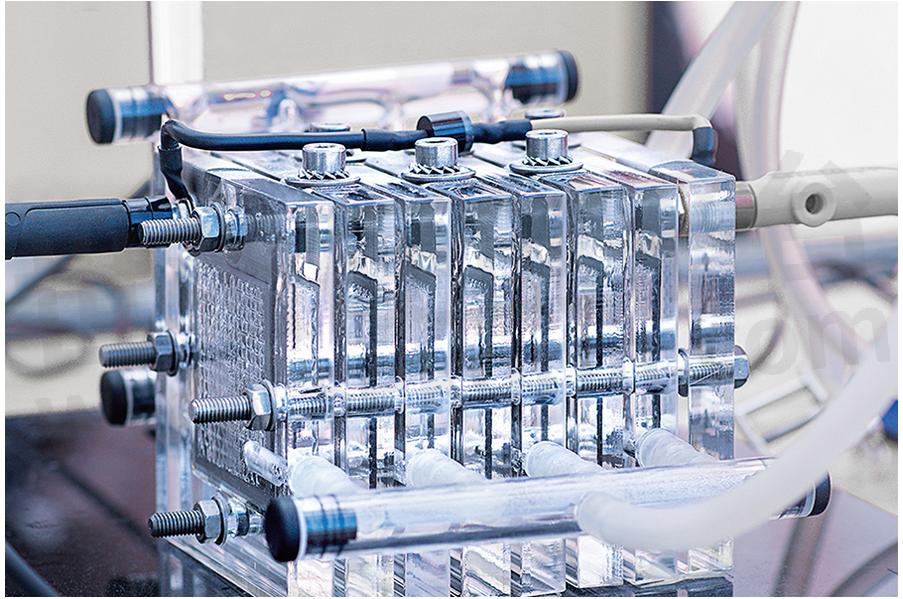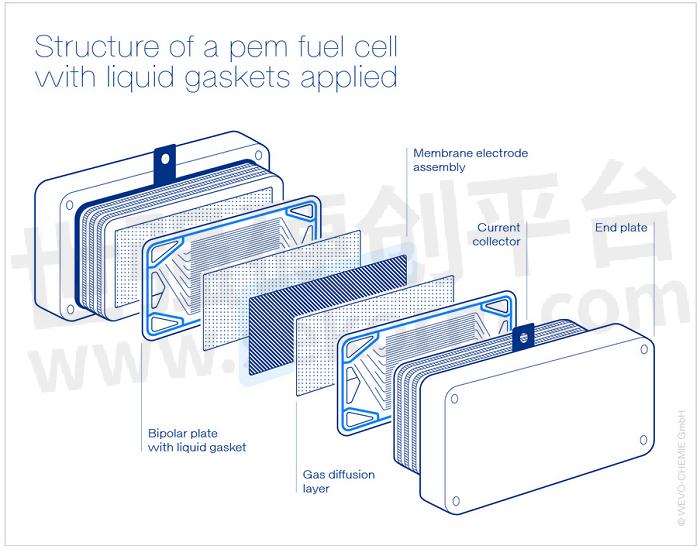Wevo Developed Silicones and Polyurethanes with a Lower Hydrogen Permeability Used as Adhesives and Sealants for PEM fuel cells

Hydrogen-based fuel cells achieve high performance and are energy-efficient. They produce no harmful emissions because only water and electrical energy are released when hydrogen reacts with oxygen. The technology, therefore, holds considerable potential for powering electric vehicles in the context of the proposed mobility transition. Since hydrogen is the smallest of all molecules, the adhesives and sealants used for fuel cells must ensure a very tight seal in order to prevent diffusion. Wevo-CHEMIE GmbH has developed silicones and polyurethanes, especially for this purpose, and their low gas permeability has been confirmed by ZBT, the hydrogen and fuel cell center in Duisburg. The products can be used both for fuel cells themselves (“stacks”) and in the surrounding system (“balance of plant”).

The low gas permeability of Wevo’s silicones and polyurethanes has been confirmed in a study by ZBT, the Duisburg hydrogen and fuel cell center.
Fuel cells consist of several functional layers that can differ both in terms of the materials and components used as well as in terms of the working principle. One of the most common types, which is currently being widely researched because of its suitability for the automotive sector, is the so-called PEM fuel cells (Proton Exchange Membrane Fuel Cells), which are shown in the figure.

The bipolar plates ensure a steady supply of hydrogen to the cells and simultaneously control the release of electrical energy. Since hydrogen is flammable and can form explosive mixtures (“oxyhydrogen”) in oxygen-containing atmospheres, reliable sealing of the individual cells is essential. The sealing materials must not only be highly impermeable to gas; they must also be resistant to challenging conditions such as continuous high temperatures of up to 120℃ or low pH. Furthermore, if the bipolar plates have tolerances due to manufacturing, this results in uneven pressure distribution on the sealing materials, which has to be compensated – especially while the stacks are being pressed.
Up to now, performed inlay gaskets have been used for this purpose, for example. However, due to the need to insert them manually on both sides of each bipolar plate, they are not suitable for the automated production of high volumes, i.e. for the automotive sector in particular. Furthermore, there is a risk that they will detach the bipolar plate during stacking so that they no longer seal effectively. The commercially available, addition-curing silicone liquid gaskets that are on offer as alternatives likewise have drawbacks, such as their generally high gas permeability and their poor adhesion to the majority of substrates. Wevo therefore developed special, chemically resistant, two-component materials based on polyurethane and silicone for use in proton exchange membrane (PEM) fuel cells. They are applied as liquid formed-in-place gaskets and also have further advantages for the manufacture and operation of fuel cell components.
LOW GAS-PERMEABLE MATERIALS FROM WEVO
The unusually low gas permeability of these materials has been confirmed by ZBT, the Duisburg hydrogen and fuel cell center, which is one of the leading research institutes in Europe in this field. One of the silicone-based products exhibited a very low hydrogen permeation coefficient of about 130 E-8 cm²/s after a measurement time of 16 hours (a figure between 500 and 1000 E-8 cm²/s is typical for addition-curing silicones). Moreover, adhesion to metal surfaces was optimized by Wevo and the compression set was reduced.
Wevo’s polyurethane sealants, which have similar thermo-mechanical properties to silicones, have even lower hydrogen permeability depending on the Shore hardness setting. Their permeation coefficients vary between about 30 and 70 E-8 cm²/s, also after a 16-hour measurement period. What’s more, these products adhere significantly better than silicones to the different substrates of bipolar plates. This prevents the seal from detaching either in the course of the manufacturing process or during stacking, so that loss of sealing effect is no longer an issue. Last but not least, much faster curing is possible compared to silicones – a major asset when it comes to automated production of high volumes.
ADHESIVES FOR STACKS, BOP COMPONENTS, AND ELECTROLYSERS
Wevo’s polyurethane-based products can additionally be used as adhesives for other applications – both within the fuel cell stack and in the balance of plant (BOP), that is the surrounding system – due to their good adhesion properties. As well as bonding the entire stack together, it is possible, for example, to simultaneously join and seal the bipolar plates’ two half-shells using customized, soft, and elastic Wevo polyurethanes. For metallic bipolar plates, this joining method can be employed as an alternative to laser welding; with plates based on graphite/polymer composites, durable bonding is a must.
Wevo products also allow the sealing and bonding of the humidifier’s components. In particular, their high ion purity and low levels of volatile components (VOC) rule out damage to the sensitive, ion-selective polymer membranes and the associated drop in performance. High hydrolysis resistance at temperatures up to 100℃ is ensured, too, by the special composition of the customized products.
The anode recirculation blower or the air compressor installed in the air circuit are other possible applications in the BOP. In the latter case, Wevo’s epoxy resins and silicones enable potting of the stator for the drive motor. By optimizing the thermal conductivity and crack resistance of the materials, the forces produced during rotation are compensated and the heat generated is removed in a targeted way. Special, thermally conductive, polyurethane potting compounds and silicone gels for the power modules are likewise used for power electronic components such as DC/DC converters, onboard chargers, and control units.
HYDROGEN PRODUCTION WITH WEVO PRODUCTS
Due to their low hydrogen permeation coefficient of only 3 to 4 E-8 cm²/s, Wevo’s customized, tough polyurethane adhesives are also suitable for various components involved in the hydrogen production process. For instance, large stacks for electrolyzers based on polymer membrane technology needed to produce “green hydrogen” can be bonded with the help of.
Alkaline electrolysis plants require adhesive systems with even higher chemical resistance than is afforded by polymer membrane technology because this widely used type of electrolyser works with aqueous potassium hydroxide solution (30–35 percent KOH) at 90 to 95℃ as its electrolyte. The majority of organic adhesive and sealing systems are not able to withstand such conditions permanently. A specially optimized, highly cross-linked, and chemical-resistant Wevo epoxy resin, which in its thixotropic form is suitable for applying adhesive beads, is one of only a few products currently available that are capable of meeting these requirements. Wevo is currently collaborating with various research institutes and industrial partners with a view to offering more solutions in this area in the future.
- +1 Like
- Add to Favorites
Recommend
- Functional Characteristics of Polyurethane Adhesive
- Application Classification of Industrial Glue
- Identification Method of Silicone Adhesive
- Rubber Repair with Polyurethane Coatings
- Wevo Customized Potting Compounds, Adhesives, and Sealants Are Facilitating Smart Cities and Power Grids
- Huitian 8960S PU Adhesive , Polyurethane Sealant Successfully Implemented at Avtovaz !
- Polyurethane Adhesive Construction Technology
- Hansi Introduces Solvent-free, Two-Component Polyurethane Adhesive YEBOND®05GP for Bonding Honeycomb and Corrugated Panels
This document is provided by Sekorm Platform for VIP exclusive service. The copyright is owned by Sekorm. Without authorization, any medias, websites or individual are not allowed to reprint. When authorizing the reprint, the link of www.sekorm.com must be indicated.





























































































































































































































































































































































































































































































































































































































































































































































































































































































